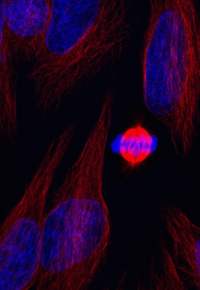 NEWS
NEWS
Research progress into cell division throws light on microtubule formation
PRESS RELEASE
-
Scientists from the Centre for Genomic Regulation (CRG) have discovered the specific mechanisms of chromosomal microtubule formation, a process exclusive to cell division and which was hitherto unknown.
- This research may prove useful for future anti-tumour therapies because it provides further information on cell division.
The cell is the smallest unit of life that we can find on the Earth. A living being can be made up of a single cell, but together with other cells this can generate the complexity of, for example, the human body. Advancing knowledge about this unit of life and the way it works remains a challenge for scientists who, even today, continue to investigate its function and composition.
In order to produce more cells and therefore renew tissues, the cells divide through a process known as mitosis. When a cell enters mitosis, the nuclear membrane disappears and the microtubules, filaments that make up the structural framework of the cell (the cytoskeleton) whose function is essential for the cell’s organisation and function, reorganise themselves to form a new structure called the mitotic spindle. The mitotic spindle segregates the two copies of the chromosomes in such a way that each daughter cell receives identical genetic information to that in the parent cell. The microtubules that make up the mitotic spindle arise in the centrosomes, located close to the chromosomes. Chromosomes play a fundamental role in the function of the mitotic spindle, as indicated by numerous studies explaining the mechanisms by which microtubules are formed in centrosomes. Nevertheless, the mechanism by which the chromosomes bring about the formation of microtubules during mitosis was not known until now.
A study published in the journal Current Biology, carried out by researchers from the CRG and led by Isabelle Vernos, group leader and ICREA investigator, reveals how the specific chromosomal microtubules form during mitosis. Although the importance of some of the proteins that take part in chromosomal microtubule formation was already known, no-one understood how they interacted among themselves and other molecules and, therefore, how exactly these microtubules were originated. For this reason, their paper helps us better comprehend the process of cell division.
“The study that we have presented is important because it reveals the specific mechanisms by which chromosomes promote the formation of microtubules during mitosis. Centrosomes generate microtubules throughout all the phases of the cell. However, those that are created near the chromosomes are specific to mitosis”, clarifies Sylvain Meunier, CRG researcher and one of the authors of the work.
“This research could be applied to tumour cells, but it is necessary not to forget that this is very basic science and its applications are long-term” explains Sylvain Meunier. The study represents another step forward towards the possible development of anti-tumoural treatments, precisely because it is a process that only occurs only during cell division: “Microtubules are one of the targets in anti-tumoural therapies because if there are no microtubules in the cell, it cannot divide. If it cannot divide, then the tumour cells and the tumour cannot get any bigger either. Since microtubules are also very important for the proper function of non-dividing cells, if we could specifically prevent the formation of mitotic microtubules we would have another, more selective tool to attack the dividing tumour cells” he adds.
This is a hugely significant component because, as Meunier explained, microtubules are a structural element of all cells. Being able to identify the factors involved specifically in cell division is the key to possible treatments. For example, microtubules are very important in the neurones for forming axons, which enable them to connect to one another. This means that if an anti-tumour treatment affected the microtubules, it would also affect those in the neurones; this could lead to side effects including neuronal problems. However, Meunier emphasizes that if the treatment targets are the specific mitotic microtubules, the treatment will affect only dividing cells.
The discovery leads the way to a new line of research into how cells divide: “Now we have to find out how the microtubules of the centrosome and chromosome integrate to form the mitotic spindle, the structure capable of organising and distributing the chromosomes correctly, avoiding errors that could lead to cell death or promote tumoural processes” explains Vernos.
Reference article: Scrofani et al., Microtubule Nucleation in Mitosis by a RanGTP-Dependent Protein Complex, Current Biology (2015), http://dx.doi.org/10.1016/j.cub.2014.11.025
For further information and interviews:
Centre for Genomic Regulation (CRG) - Press Office
Lidia Montes / Laia Cendrós
Tel. +34 93 316 02 37

